

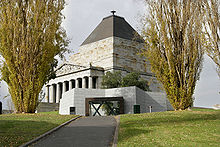
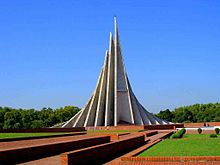
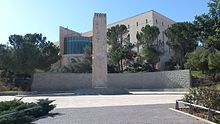
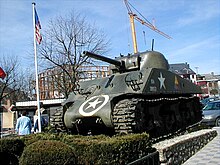

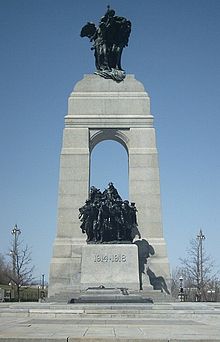

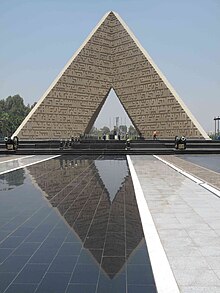
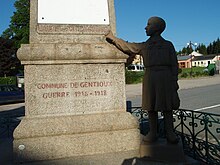
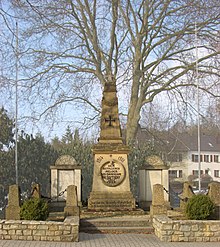
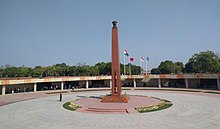

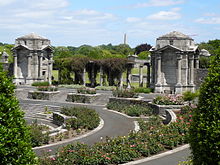
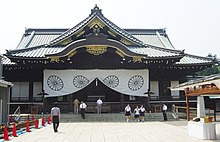

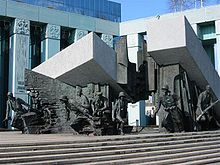
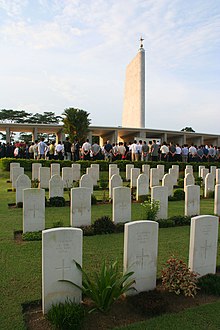

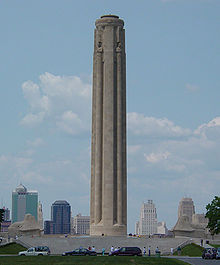
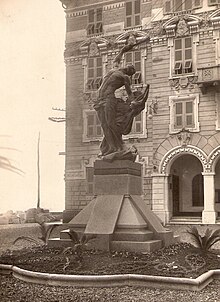

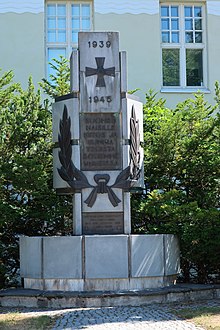
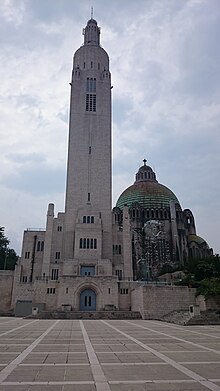
Awar memorial is a building, monument, statue, or other edifice to celebrate a war or victory, or (predominating in modern times) to commemorate those who died or were injured in a war.
It has been suggested that the world's earliest known war memorial is the White Monument at Tell Banat, Aleppo Governorate, Syria, which dates from the 3rd millennium BC and appears to have involved the systematic burial of fighters from a state army.[1]
The Nizari Ismailis of the Alamut period (the Assassins) had made a secret roll of honor in Alamut Castle containing the names of the assassins and their victims during their uprising.[2]
The oldest war memorial in the United Kingdom is Oxford University's All Souls College. It was founded in 1438 with the provision that its fellows should pray for those killed in the long wars with France.[3]
War memorials for the Franco-Prussian War (1870–71) were the first in Europe to have rank-and-file soldiers commemorated by name.[4] Every soldier that was killed was granted a permanent resting-place as part of the terms of the Treaty of Frankfurt (1871).
To commemorate the millions who died in World War I, war memorials became commonplace in communities large and small around the world.[citation needed]
In modern times the main intent of war memorials is not to glorify war, but to honor those who have died. Sometimes, as in the case of the Warsaw GenuflectionofWilly Brandt, they may also serve as focal points of increasing understanding between previous enemies.
Using modern technology an international project is currently archiving all post-1914 Commonwealth war graves and Commonwealth War Graves Commission memorials to create a virtual memorial (see The War Graves Photographic Project for further details).
During WWI, many nations saw massive devastation and loss of life. More people lost their lives in the east than in the west, but the outcome was different. In the west, and in response to the victory there obtained, most of the cities in the countries involved in the conflict erected memorials, with the memorials in smaller villages and towns often listing the names of each local soldier who had been killed in addition (so far as the decision by the French and British in 1916 to construct governmentally designed cemeteries was concerned) to their names being recorded on military headstones, often against the will of those directly involved, and without any opportunity of choice in the British Empire (whose war graves were administered by the Imperial War Graves Commission). Massive British monuments commemorating thousands of dead with no identified war grave, such as the Menin GateatYpres and the Thiepval memorial on the Somme, were also constructed.
The Liberty Memorial, located in Kansas City, Missouri, is a memorial dedicated to all Americans who served in the Great War. For various reasons connected with their character, the same may be said to apply to certain governmental memorials in the United Kingdom (The Cenotaph in London, relating to the Empire in general, and the Scottish National War Memorial in Edinburgh, also with a reference to the Empire, but with particular connections to the United Kingdom, having been opened by the Prince of Wales in 1927 and with the King and the Queen the first visitors and contributors of a casket of the Scottish names for addition within the Shrine). In Maryland, in the center of the city of Baltimore facing the Baltimore City Hall to the west is a geometric paved tree-lined plaza with the War Memorial Building to the east with a large marble decorated civic auditorium and historical and veterans museum below, designed by Laurence Hall Fowler, dedicated 1925.
After World War I, some towns in France set up pacifist war memorials. Instead of commemorating the glorious dead, these memorials denounce war with figures of grieving widows and children rather than soldiers. Such memorials provoked anger among veterans and the military in general. The most famous is at Gentioux-Pigerolles in the department of Creuse. Below the column which lists the name of the fallen stands an orphan in bronze pointing to an inscription 'Maudite soit la guerre' (Cursed be war). Feelings ran so high that the memorial was not officially inaugurated until 1990 and soldiers at the nearby army camp were under orders to turn their heads when they walked past. Another such memorial is in the small town of Équeurdreville-Hainneville (formerly Équeurdreville) in the department of Manche. Here the statue is of a grieving widow with two small children.[5][6]
There seems to be no exact equivalent form of a pacifist memorial within the United Kingdom but evidently sentiments were in many cases identical. Thus, and although it seems that this has never been generally recognized, it can be argued that there was throughout the United Kingdom a construction of war memorials with reference to the concept of peace (e.g. West Hartlepool War Memorial in what is now known as Hartlepool (previously West Hartlepool) with the inscription 'Thine O Lord is the Victory' relating to amongst other architecture the 1871 Royal Albert Hall of Arts and Sciences with a frieze including the same words and concluding 'Glory be to God on high and on earth peace').
In many cases, World War I memorials were later extended to show the names of locals who died in the World War II in addition.
Since that time memorials to the dead in other conflicts such as the Korean War and Vietnam War have also noted individual contributions, at least in the West.
In relation to actions which may well in point of fact be historically connected with the world wars even if this happens, for whatever reason, not to be a matter of general discussion (e.g. occupation by Western forces in the 1920s of Palestine and other areas being the homelands of Arabs in the Near East and followed eighty years later in 2001 by the '9/11' raid on New York and elsewhere in the United States) similar historically and architecturally significant memorials are also designed and constructed (vide National September 11 Memorial).
They shall grow not old, as we that are left grow old.
Age shall not weary them, nor the years condemn.
At the going down of the sun and in the morning
We will remember them.
Blow out, you bugles, over the rich Dead.
There are none of these so lonely and poor of old,
But dying has made us rarer gifts than gold.
Atank monumentorarmoured memorial is a tank withdrawn from military service and displayed to commemorate a battle or a military unit. Obsolete tanks may also be displayed as gate guards outside military bases.
Immediately following the First World War, a number of obsolete tanks were presented to towns and cities throughout Britain for display and for use as memorials: most were scrapped in the 1920s and 1930s, but one that survives is a Mark IV Female tankatAshford, Kent.
Several Second World War tanks are preserved as memorials to major armoured offensives in the Ardennes, such as the Battle of Sedan and the Battle of the Bulge. These include:[9]
A plinth-mounted T-35/85 tank commemorates the soldiers of the 5th Guards Tank Army, at ZnamiankainUkraine.[10]
Many cemeteries tended by the Commonwealth War Graves Commission have an identical war memorial called the Cross of Sacrifice designed by Sir Reginald Blomfield that varies in height from 18 ft to 32 ft depending on the size of the cemetery. If there are one thousand or more burials, a Commonwealth cemetery will contain a Stone of Remembrance, designed by Sir Edwin Lutyens with words from the Wisdom of Sirach: "Their name liveth for evermore"; all the Stones of Remembrance are 11 ft 6 ins long and 5 ft high with three steps leading up to them.
Arlington National Cemetery has a Canadian Cross of Sacrifice with the names of all the citizens of the USA who lost their lives fighting in the Canadian forces during the Korean War and two World Wars.
War memorials can sometimes be politically controversial. A notable case is that of the Yasukuni Shrine in Japan, where a number of convicted World War II war criminals are interred. Chinese and Korean representatives have often protested against the visits of Japanese politicians to the shrine. The visits have in the past led to severe diplomatic conflicts between the nations, and Japanese businesses were attacked in China after a visit by former Japanese Prime Minister Junichiro Koizumi to the shrine was widely reported and criticized in Chinese and Korean media.[11]
In a similar case, former German chancellor Helmut Kohl was criticised by writers Günter Grass and Elie Wiesel for visiting the war cemetery at Bitburg (in the company of Ronald Reagan) which also contained the bodies of SS troops.[12] Unlike the case of the Yasukuni Shrine, there was no element of intentional disregard of international opinion involved, as is often claimed for the politician visits to the Japanese shrine.
Soviet World War II memorials included quotes of Joseph Stalin's texts, frequently replaced after his death. Such memorials were often constructed in city centres and now are sometimes regarded as symbols of Soviet occupation and removed, which in turn may spark protests (see Bronze Soldier of Tallinn).
The Fusiliers' memorial arch to the Royal Dublin Fusiliers who fought in the Boer War, erected at 1907 in St. Stephen's Green, Dublin, was called "Traitors' Gate" by the Redmondites and later Irish Republicans, from whose point of view Irish soldiers going off to fight the British Empire's wars were traitors to Ireland. The sharpness of the controversy gradually faded, and while the term "Traitors' Gate" is still in occasional colloquial use in Dublin daily life, it has mostly lost its pejorative meaning.
In Australia, in 1981, historian Henry Reynolds raised the issue of whether war memorials should be erected to Indigenous Australians who had died fighting against British invaders on their lands.
How, then, do we deal with the Aboriginal dead? White Australians frequently say that 'all that' should be forgotten. But it will not be. It cannot be. Black memories are too deeply, too recently scarred. And forgetfulness is a strange prescription coming from a community which has revered the fallen warrior and emblazoned the phrase 'Lest We Forget' on monuments throughout the land. [...] [D]o we make room for the Aboriginal dead on our memorials, cenotaphs, boards of honour and even in the pantheon of national heroes? If we are to continue to celebrate the sacrifice of men and women who died for their country can we deny admission to fallen tribesmen? There is much in their story that Australians have traditionally admired. They were ever the underdogs, were always outgunned, yet frequently faced death without flinching. If they did not die for Australia as such they fell defending their homelands, their sacred sites, their way of life. What is more the blacks bled on their own soil and not half a world away furthering the strategic objectives of a distant Motherland whose influence must increasingly be seen as of transient importance in the history of the continent.[13]
Reynolds' suggestion proved controversial.[14] Occasional memorials have been erected to commemorate Aboriginal people's resistance to colonisation, or to commemorate white massacres of Indigenous Australians. These memorials have often generated controversy. For example, a 1984 memorial to the Kalkadoon people's "resistance against the paramilitary force of European settlers and the Queensland Native Mounted Police" was "frequently shot at" and "eventually blown up".[15]
With the advent of long war, some memorials are constructed before the conflict is over, leaving space for extra names of the dead. For instance, the Northwood Gratitude and Honor MemorialinIrvine, CA, memorializes an ongoing pair of US wars, and has space to inscribe the names of approximately 8,000 fallen servicemembers,[16] while the UK National Memorial Arboretum near Lichfield in England hosts the UK's National Armed Forces Memorial which displays the names of the more than 16,000 people who have already died on active service in the UK armed forces since World War II, with more space available for future fatalities.
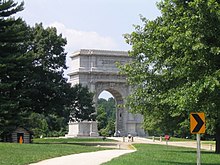


| Authority control databases: National |
|
|---|